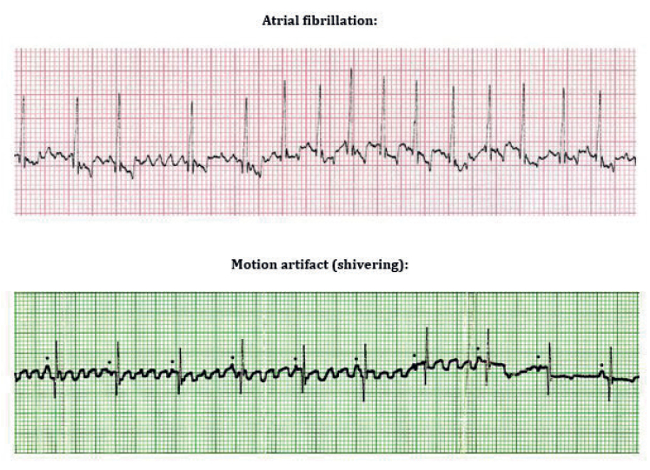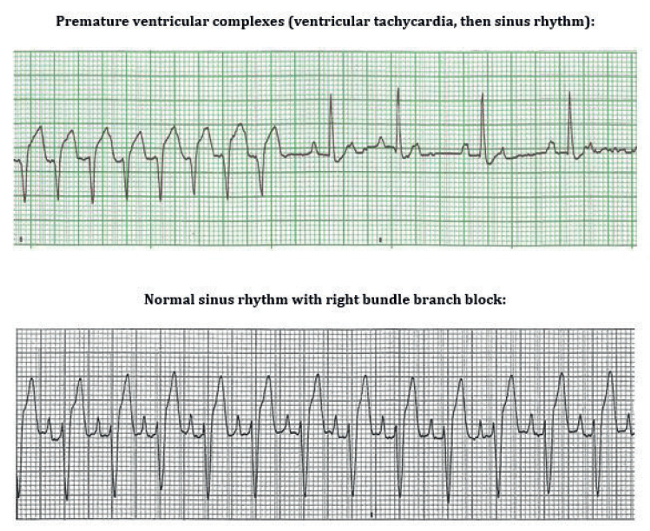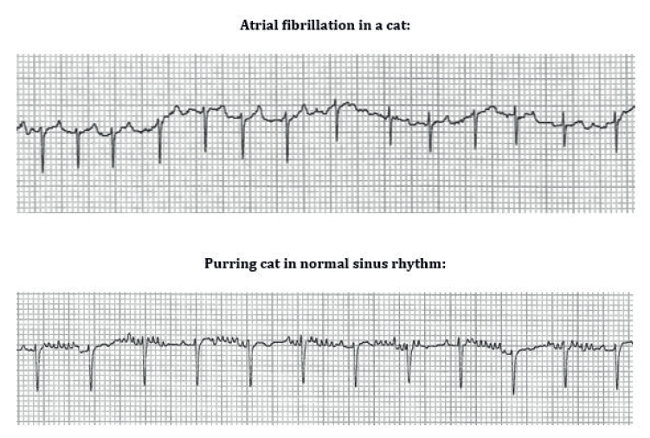Atlantic Veterinary College, University of Prince Edward Island, Charlottetown, PE, Canada
Introduction
Abnormalities of the electrocardiogram (ECG) are a common abnormality in small animal practice. Such abnormalities can be the first sign of an important problem in a patient. However, ECGs also are prone to misinterpretation, which carries the risk of erroneous diagnosis and inappropriate treatment. The first step in managing patients with suspicious ECG findings is to accurately analyze the ECG tracing.
This presentation will review common ECG impostors, and the real ECG abnormalities they imitate, to help in the accurate identification and management of affected patients. This information should be of interest to nurse technicians but also to all other members of the animal healthcare team.
| Atrial fibrillation or atrial flutter, versus motion artifact | 
|
|
| |
Dilemma
Repetitive motion artifact, like shivering, can be mistaken for atrial fibrillation or atrial flutter because of the fine baseline deflections that such artifacts can cause. These can be deceptively similar to fibrillation or flutter waves.
Solution
In the vast majority of cases, atrial fibrillation and atrial flutter are associated with an irregularly irregular R-R interval. This is in contrast to the regular R-R interval seen in a patient with movement artifact if that patient is in sinus rhythm.
Also, as is true with all artifacts, it is important to look for evidence of organized electrical activity that proves the arrhythmia is not affecting the cardiac chambers in question. For example, in the tracing above, showing shivering artifact, the atria cannot be fibrillating, because close inspection reveals P waves (indicated by dots). P waves are created by organized atrial depolarization, and no part of the heart can simultaneously fibrillate and depolarize in an organized fashion; i.e., it must be superimposed artifact.
Dilemma
Ventricular tachycardia can be monomorphic ("same shape"), as seen above: the premature ventricular complexes that comprise the ventricular tachycardia are all of the same wide, bizarre shape. This appearance is deceptively similar to panting artifact, as seen in the second tracing.
Solution
Note that the wide, bizarre deflections in the second tracing are not identical; instead, they look different in a repeatable, evenly spaced pattern (arrows). This is the appearance of the underlying rhythm (likely sinus rhythm) with superimposed artifact, typically panting, but possibly any rapid, repetitive movement.
| Premature ventricular complexes versus normal sinus rhythm with right bundle branch block | 
|
|
| |
Dilemma
Wide, bizarre QRS complexes most commonly are premature ventricular complexes. However, other explanations exist for wide, bizarre QRS complexes, including sinus rhythm with right bundle branch block, which is usually a harmless physiologic variant with no clinical repercussions on the patient. Misdiagnosing normal sinus rhythm with right bundle branch block as a ventricular arrhythmia risks triggering a degree of monitoring, an implementation of treatment, and a worsening of prognosis that are all unjustified and could harm the patient.
Solution
Normal sinus rhythm with right bundle branch block is an intraventricular conduction disturbance. This means it does not affect the formation and initial propagation of the cardiac impulse through the atria, through the atrioventricular node, and into the initial part of the ventricles. The ECG from a patient that has normal sinus rhythm with right bundle branch block shows a P wave clearly preceding each QRS complex at a fixed PR interval, whereas in ventricular tachycardia, no such evidence of atrioventricular association exists.
| Atrial fibrillation versus purring (cat) | 
|
|
| |
Dilemma
When cats purr, the artifact created on the ECG can mimic atrial fibrillation or flutter.
Solution
As with all artifacts, close inspection can usually reveal evidence of normal functioning of the heart chambers that were thought to be functioning abnormally. For example, in the tracing showing purring artifact, above, the fine undulating baseline deflections caused by purring could be misinterpreted as intermittent atrial fibrillation or flutter waves. However, there are clear P waves preceding each QRS complex at a constant PR interval. P waves represent organized atrial electrical activity. Therefore, atrial fibrillation and flutter are ruled out in that tracing based on the principle that a cardiac chamber cannot simultaneously fibrillate (or flutter) and depolarize normally. Furthermore, as described for the first pair of ECG tracings ("Atrial fibrillation or atrial flutter, versus motion artifact"), atrial fibrillation and flutter virtually always cause a variable R-R interval; in the 2 feline ECGs shown here, the variable R-R interval is apparent on the one that shows true atrial fibrillation, but not on the ECG that shows purring artifact in a cat with normal sinus rhythm.